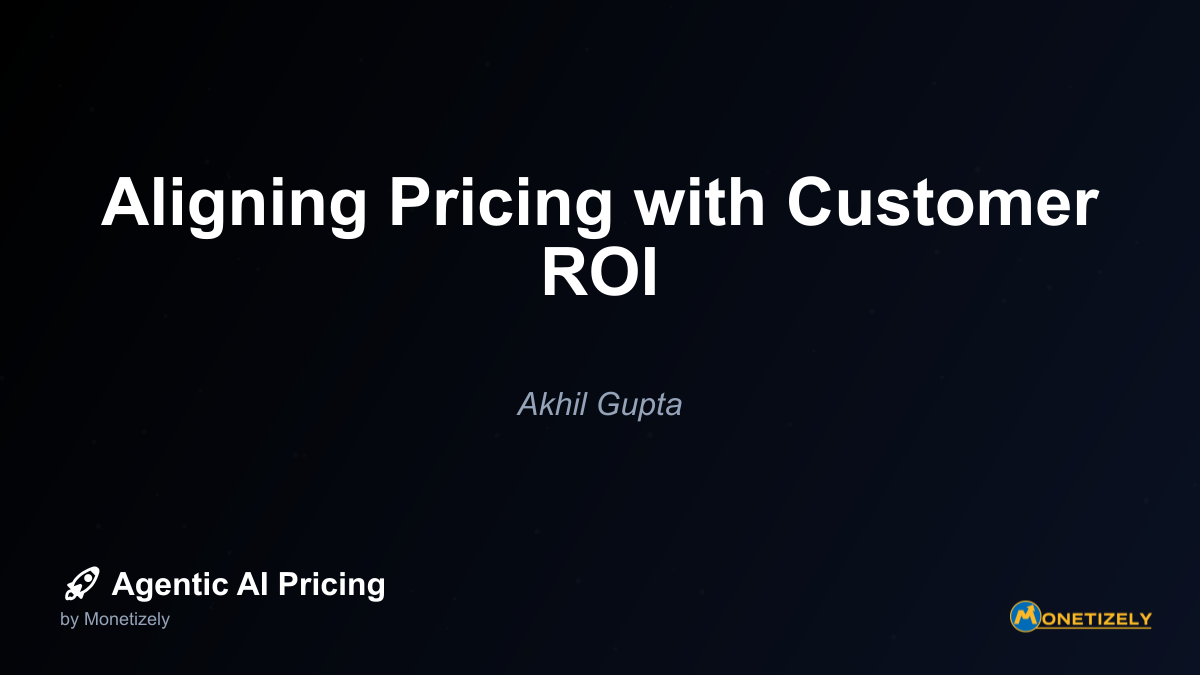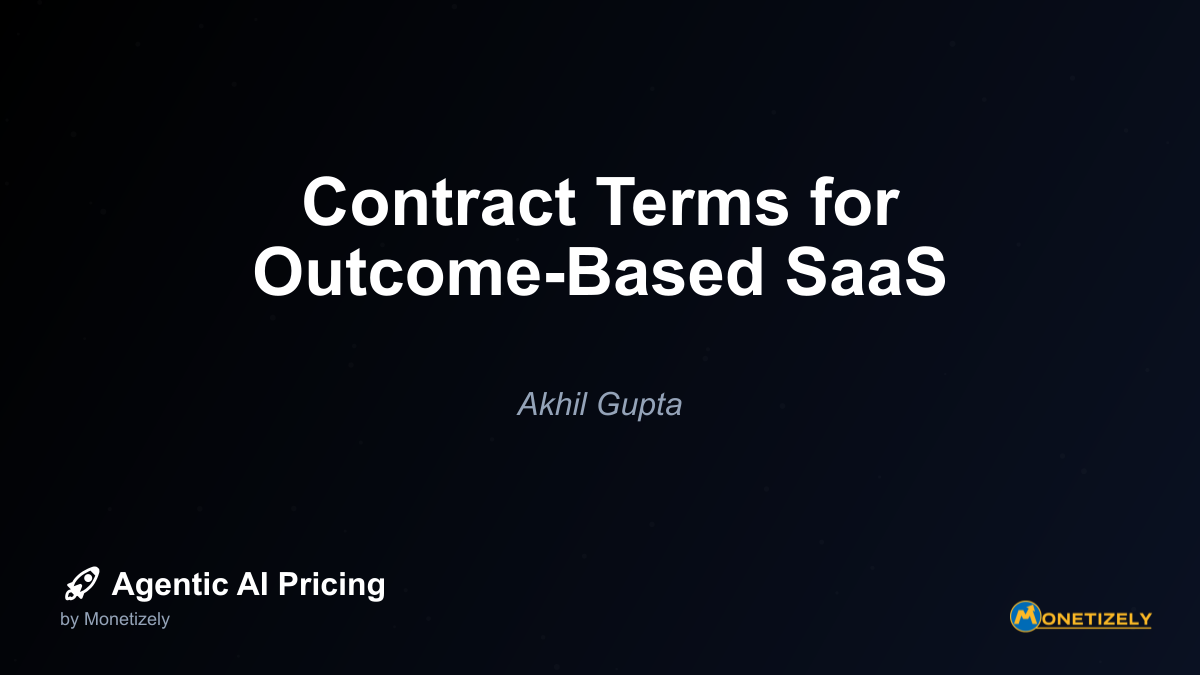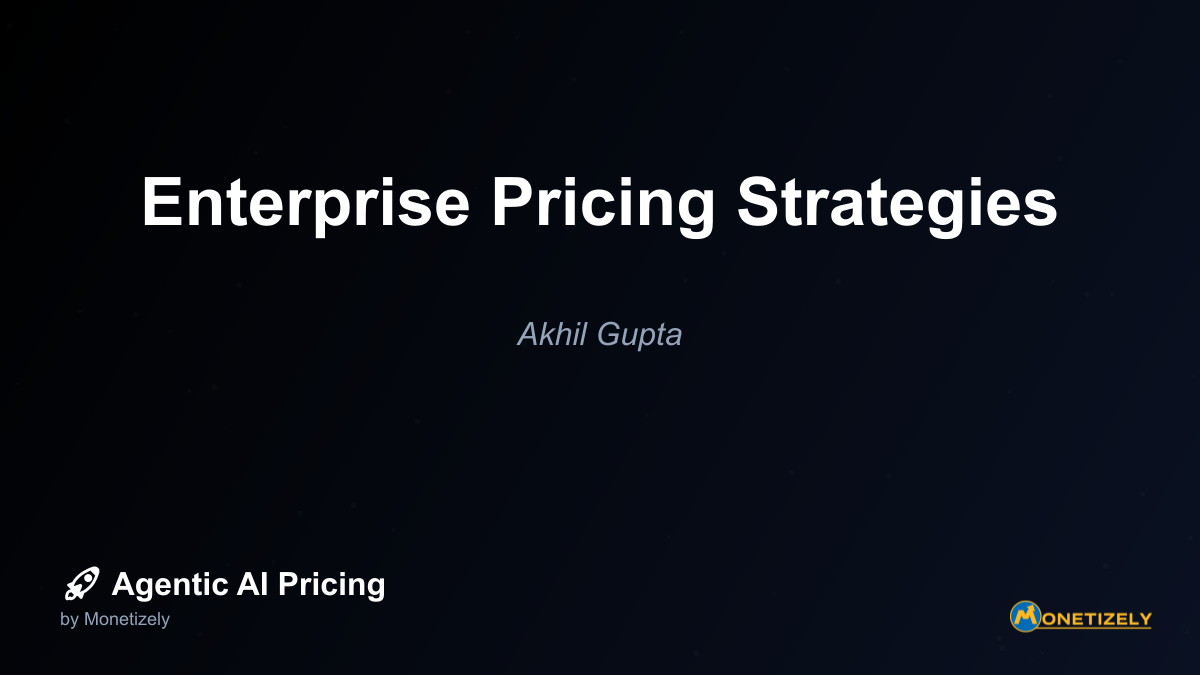· Ajit Ghuman · Pricing Agentic SaaS Products · 9 min read
Value Metrics That Matter in Pricing
AI and SaaS Pricing Masterclass
Learn the art of strategic pricing directly from industry experts. Our comprehensive course provides frameworks and methodologies for optimizing your pricing strategy in the evolving AI landscape. Earn a professional certification that can be imported directly to your LinkedIn profile.

The Value Alignment Principle in Metric Selection
The cornerstone of effective agentic AI pricing is the Value Alignment Principle: your pricing metrics should directly correlate with the value your customers receive. This principle sounds straightforward but requires careful consideration in practice.
For agentic AI, value often manifests in one of several ways:
- Time saved: Agents automating tasks that would otherwise require human attention
- Quality improvements: Agents making better decisions than human counterparts
- Scale advantages: Agents handling volumes impossible for human teams
- Risk reduction: Agents preventing costly errors or identifying opportunities
- Novel capabilities: Agents enabling entirely new business functions
Each of these value dimensions suggests different potential pricing metrics. The challenge lies in selecting metrics that accurately reflect the specific value your solution delivers.
Categorizing Value Metrics for Agentic AI
Let’s examine the main categories of metrics that can serve as the foundation for agentic AI pricing:
1. Input-Based Metrics
Input metrics focus on what goes into the system:
- Data volume processed: Charging based on gigabytes ingested
- API calls: Pricing according to requests made to the agent
- Prompt tokens: Measuring the input text that drives agent behavior
- Complexity factors: Pricing based on difficulty of tasks assigned
While easy to measure, input metrics often create misalignment. A customer might pay more for inefficient processing that requires more data or API calls, even if the outcomes don’t improve.
2. Output-Based Metrics
Output metrics measure what the system produces:
- Actions taken: Pricing based on discrete tasks completed
- Decisions made: Charging per recommendation or choice
- Content generated: Measuring the volume of output produced
- Reports delivered: Counting tangible deliverables
Output metrics improve alignment but still miss the mark if the outputs themselves don’t directly correlate with customer value. A thousand mediocre recommendations might cost more than one brilliant insight.
3. Outcome-Based Metrics
Outcome metrics focus on actual business results:
- Revenue generated: Charging a percentage of incremental sales
- Costs reduced: Sharing in documented savings
- Time saved: Pricing based on human hours eliminated
- Error reduction: Measuring improvements in quality metrics
- Compliance improvements: Tracking regulatory adherence
Outcome metrics create the tightest alignment between pricing and value but present implementation challenges. They require sophisticated tracking systems and agreement on attribution methodologies.
4. Hybrid Metrics
Many successful agentic AI pricing models combine elements from multiple categories:
- Base fee + performance incentives: Covering costs while sharing in upside
- Tiered consumption with outcome accelerators: Volume discounts that adjust based on results
- Capability access with usage components: Fixed fees for features with variable charges for consumption
These hybrid approaches balance predictability for both vendor and customer while maintaining value alignment.
The Metric Selection Framework
When evaluating potential pricing metrics for your agentic AI solution, consider these five criteria:
1. Alignment with Customer Value
Key questions:
- Does the metric directly correlate with what customers value most?
- Will customers intuitively understand the connection between usage and pricing?
- Does the metric scale proportionally with the benefits received?
The strongest metrics demonstrate clear causality between consumption and value. If your agent saves procurement teams time by automatically negotiating with vendors, charging per negotiation completed creates natural alignment.
2. Measurability and Transparency
Key questions:
- Can the metric be accurately measured without dispute?
- Is measurement straightforward or overly complex?
- Can customers easily verify the usage data?
- Will customers trust the measurement methodology?
Metrics that require complex calculations or rely on opaque methodologies create friction. If customers can’t verify what they’re being charged for, they’ll resist the pricing model regardless of its theoretical merits.
3. Predictability and Budgeting
Key questions:
- Can customers reasonably forecast their costs?
- Does the metric create unpredictable spending spikes?
- Can customers control their usage if needed?
Even perfectly aligned metrics fail if they create budgeting nightmares. Customers need to predict costs with reasonable accuracy. Metrics tied to volatile business processes may require caps or smoothing mechanisms.
4. Implementation Complexity
Key questions:
- Can your billing systems handle this metric?
- What engineering work is required to track usage?
- Are there privacy or security implications to tracking this metric?
- How will you handle disputes or measurement errors?
The practical aspects of implementation matter tremendously. A theoretically perfect metric that requires rebuilding your entire infrastructure isn’t viable for most companies.
5. Market Readiness and Education
Key questions:
- Are customers familiar with this type of metric?
- How much education will the sales process require?
- Do competitors use similar metrics, creating a basis for comparison?
- Will the metric create friction in the sales process?
Novel metrics require customer education. While innovation can differentiate your offering, radical departures from industry norms create adoption barriers that may outweigh their benefits.
Industry-Specific Metric Considerations
Different sectors have unique value drivers that influence metric selection:
Financial Services
In financial services, agentic AI often focuses on risk reduction, fraud detection, and investment optimization. Effective metrics include:
- Basis points on assets managed: Aligns with industry norms while reflecting value
- Fraud prevention savings: Percentage of prevented losses
- Regulatory compliance events: Reduction in violations or reporting errors
- Decision support volume: Number of investment decisions augmented
The high regulatory burden in financial services means metrics must be auditable and defensible to compliance teams.
Healthcare
Healthcare agentic AI typically delivers value through improved diagnoses, operational efficiency, and patient outcomes. Consider metrics like:
- Cases processed: Number of patient files analyzed
- Time-to-diagnosis reduction: Measured in hours saved
- Treatment plan optimizations: Counted per improvement suggestion
- Administrative automation: Measured in staff hours redirected to care
Healthcare metrics must navigate complex privacy regulations while demonstrating tangible improvements in care quality or efficiency.
E-commerce and Retail
In retail contexts, agentic AI often drives revenue through personalization, inventory optimization, and customer service. Relevant metrics include:
- Conversion lift percentage: Share of incremental sales
- Cart size improvements: Measured in average order value increases
- Inventory turnover acceleration: Reduction in days of inventory
- Customer service resolutions: Number of inquiries successfully handled
Retail metrics benefit from the industry’s data-rich environment, enabling sophisticated attribution models.
Manufacturing and Supply Chain
Manufacturing applications of agentic AI typically focus on efficiency, quality control, and predictive maintenance. Consider metrics such as:
- Downtime prevention: Hours of operation preserved
- Quality improvement: Reduction in defect rates
- Predictive alerts: Number of maintenance interventions optimized
- Throughput increases: Additional production capacity created
Manufacturing metrics often require integration with operational technology systems, creating technical implementation challenges.
Common Pitfalls in Metric Selection
Even with careful planning, several common traps ensnare companies implementing agentic AI pricing:
1. The Technical Metric Trap
Many companies default to technical metrics like “API calls” or “compute time” because they’re easy to measure. These rarely align with customer value and often create perverse incentives where inefficient systems cost customers more.
Solution: Start with customer value and work backward to find measurable proxies, not the other way around.
2. The Complexity Overload
Some pricing models combine so many metrics that customers can’t reasonably forecast costs. This complexity creates sales friction and drives customers toward simpler competitors.
Solution: Limit your model to 2-3 primary metrics that capture most of the value variation. Use tiers and bundles to handle edge cases rather than additional metrics.
3. The Attribution Problem
Outcome-based metrics often stumble on attribution questions. If revenue increases after implementing an AI agent, how much credit goes to the agent versus other factors?
Solution: Develop clear attribution methodologies upfront, potentially using control groups or baseline comparisons. Consider partial attribution models that acknowledge multiple contributing factors.
4. The Cannibalization Fear
Some metrics incentivize customers to minimize usage, potentially reducing the value they receive. For example, charging per API call might discourage beneficial integrations.
Solution: Ensure metrics align with value creation, not just resource consumption. Consider declining pricing tiers that encourage rather than penalize increased usage.
5. The Implementation Gap
Many theoretically sound metrics fail because companies can’t accurately measure them or integrate them with billing systems.
Solution: Involve technical teams early in metric selection. Build measurement capabilities before committing to metrics that require them.
Evolving Metrics Through the Product Lifecycle
The ideal pricing metric often changes as products mature and market understanding evolves:
Early-Stage Products
Early-stage agentic AI products benefit from simpler metrics focused on adoption:
- Flat subscription fees: Removing usage anxiety to encourage exploration
- Capability-based tiers: Differentiating by features rather than consumption
- Generous free tiers: Allowing substantial value before payment
Simple models reduce friction when customers are still learning the product’s value.
Growth-Stage Products
As products gain traction, metrics can evolve to better capture value variation:
- Basic usage metrics: Introducing consumption-based components
- Simple outcome measures: Beginning to tie pricing to results
- Segmented approaches: Tailoring metrics to different customer types
This stage often sees the introduction of hybrid models that balance predictability with value alignment.
Mature Products
Mature agentic AI products can implement sophisticated metrics that tightly align with value:
- Complex outcome measures: Directly tying pricing to business results
- Customer-specific models: Tailoring metrics to individual value cases
- Dynamic pricing systems: Adjusting in real-time based on value delivered
The deep customer relationships and product understanding at this stage enable more complex approaches.
How to Test New Metrics Before Full Implementation
Before committing to pricing metrics, prudent companies test them thoroughly:
- Shadow billing: Calculate what customers would pay under new metrics without actually charging them
- Customer simulations: Work with select customers to model costs under various usage scenarios
- Pilot programs: Implement new metrics with a small customer segment
- A/B testing: Offer different metric options to similar customer segments and compare results
- Phased rollouts: Gradually transition from old to new metrics with overlapping periods
These approaches reduce risk while providing valuable data on customer reactions and potential implementation challenges.
Value Metrics in Action: Case Studies
Case Study 1: Legal Research Agent
A legal AI assistant helping attorneys with case research initially charged per search query. However, they discovered that value varied dramatically based on the complexity and impact of cases. They transitioned to a hybrid model:
- Base subscription covering routine matters
- Premium fees for high-stakes litigation
- Volume discounts based on firm size
This approach better aligned with how law firms budget and the varying value of different legal matters.
Case Study 2: Manufacturing Optimization Agent
An AI system optimizing factory operations initially charged based on the number of production lines monitored. After collecting performance data, they shifted to a shared-savings model:
- Minimum monthly fee covering implementation costs
- Percentage of documented efficiency improvements
- Bonus incentives for meeting specific KPIs
This approach created true partnership with customers while demonstrating confidence in their solution’s effectiveness.
Case Study 3: Marketing Content Agent
An AI agent generating marketing content started with a per-word pricing model. Customer feedback revealed that value came not from volume but from performance. They evolved to:
- Tiered packages based on content types
- Performance adjustments tied to engagement metrics
- Integration fees for connecting to distribution channels
This nuanced approach recognized that different content types delivered varying value and encouraged quality over quantity.
Conclusion: Finding Your Value Metric
Selecting the right value metrics for agentic AI pricing requires balancing theoretical alignment with practical implementation. The most successful approaches:
- Start with a deep understanding of how customers derive value
- Select metrics that directly correlate with that value
- Ensure transparent, verifiable measurement
- Build systems that can accurately track and bill based on chosen metrics
- Educate customers on the connection between metrics and value
- Evolve metrics as products mature and markets develop
The companies that master this balance create pricing models that accelerate adoption while capturing fair value for their innovations. As agentic AI continues to transform industries, those with value-aligned pricing will enjoy sustainable competitive advantages.
The journey to perfect pricing metrics never truly ends—it evolves alongside your product and market. By focusing relentlessly on customer value and avoiding the common pitfalls outlined above, you can develop pricing models that drive both adoption and profitability in the emerging agentic AI landscape.
Co-Founder & CEO
Ajit is the author of Price To Scale, a top book on SaaS Pricing and is the Founder of Monetizely. Ajit has led and worked in pricing and product marketing at firms like Twilio, Narvar and Medallia. His work has been featured in Forbes and VentureBeat. Ajit regularly consults with software companies from Seed stage to post-IPO on pricing strategy. Ajit is also a highly-rated co-instructor for 'The Art of SaaS Pricing and Monetization' on Maven.
Pricing Strategy Audit
Let our experts analyze your current pricing strategy and identify opportunities for improvement. Our data-driven assessment will help you unlock untapped revenue potential and optimize your AI pricing approach.




